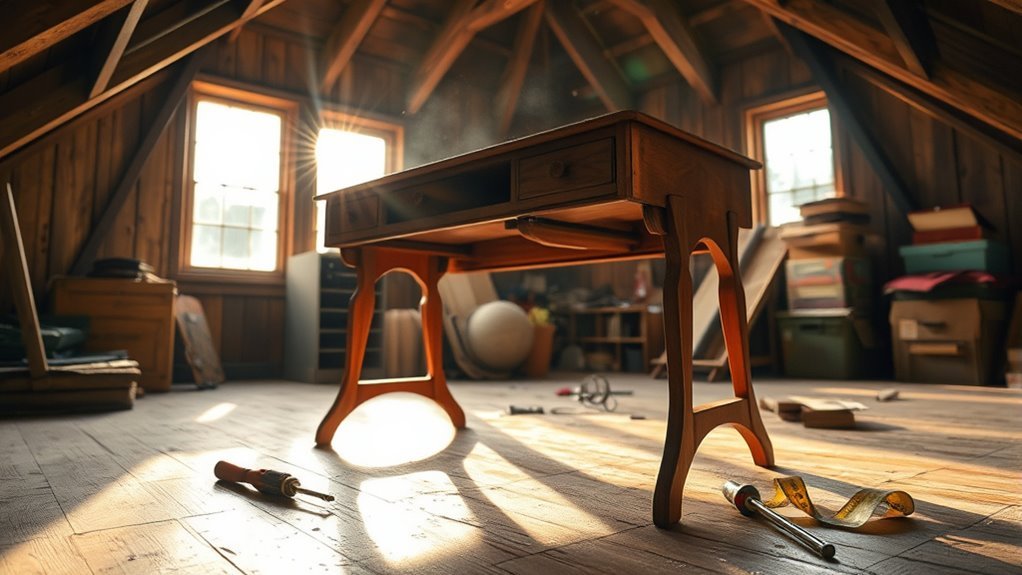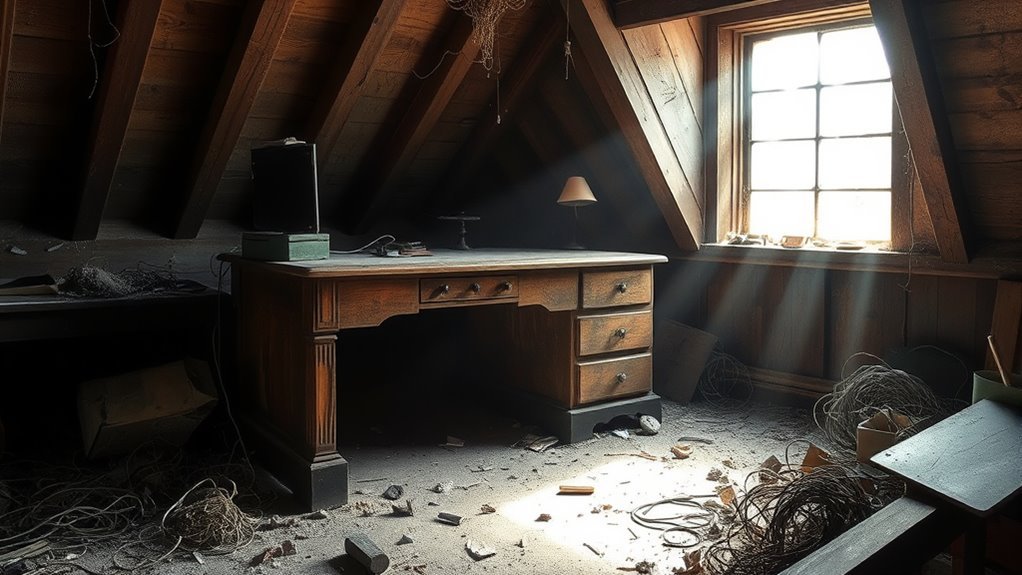Removing Desk From Attic Effectively
When removing a desk from your attic, start by measuring both the desk and attic access points to plan the best route. Gather tools like screwdrivers, gloves, and goggles for safety. Disassemble the desk carefully, removing drawers and legs first to lighten it. Navigate tight spaces slowly with help, taking off doors if needed for extra room. Afterward, clean and organize the attic to leave it tidy. Keep going to find out how to handle tricky corners and protect your furniture.
Assessing the Attic Space and Desk Dimensions

Before you start moving the desk, you’ll want to carefully measure both the attic space and the desk itself. This step is essential to maintain attic organization and guarantee the desk’s functionality isn’t compromised during removal. You’ll need exact dimensions of the desk—height, width, and depth—and compare them to the attic’s access points, including doorways and staircases. Knowing these measurements helps you plan the best route and avoid damage. By evaluating the attic space, you can also identify any obstacles that could hinder your freedom to move around. Taking the time to measure accurately saves effort and frustration, making your removal process smoother and preserving both your attic’s order and the desk’s usability for its next destination.
Preparing Tools and Safety Equipment
Gathering the right tools and safety gear is crucial for removing a desk from your attic efficiently and without injury. Before you start, focus on safety precautions and gather essential tools to make the process smooth and secure. Below is a quick guide to what you’ll need:
| Tool/Equipment | Purpose | Safety Tip |
|---|---|---|
| Screwdriver set | To loosen screws | Use gloves to protect hands |
| Work gloves | Protect your hands | Verify a snug fit |
| Safety goggles | Protect eyes from dust | Always wear when handling wood |
| Dust mask | Prevent inhaling dust | Replace if damp or dirty |
| Flashlight | Illuminate dark attic areas | Check batteries beforehand |
| Ladder | Safe access to attic | Confirm it’s stable and secure |
With these essentials, you’re set to work safely and freely.
Disassembling the Desk for Easier Removal

Once you’ve guaranteed your workspace is clear and well-lit, you’ll want to start disassembling the desk carefully to make removal easier. Breaking down the desk reduces its bulk, giving you more freedom to maneuver it out without hassle. Focus on the desk assembly to understand which parts come apart smoothly. Here are some key removal techniques to keep in mind:
Clear your workspace, then carefully disassemble the desk to reduce bulk and simplify removal.
- Remove drawers and shelves first to lighten the load and prevent damage.
- Unscrew legs and supports systematically, keeping screws organized for reassembly.
- Detach the desktop surface last, as it’s often the largest and heaviest piece.
Navigating Tight Spaces and Stairways
How will you maneuver the desk through narrow hallways and staircases without causing damage? First, plan your tight space strategies carefully. Measure doorways, landings, and stair widths to anticipate tricky spots. Removing doors temporarily can free up space. When traversing stairways, prioritize stairway safety—always have a clear path and secure footing. Use helpers to guide the desk, communicating clearly with each step. Tilt and pivot the desk slowly to fit around corners, avoiding sudden movements. Consider protective padding on corners and walls to prevent scratches. Taking your time lets you stay in control, minimizing risk and frustration. With the right approach, you’ll glide the desk down safely, keeping both your freedom and your space intact.
Cleaning and Restoring the Attic After Removal

After carefully maneuvering the desk out of your attic, you’ll want to focus on cleaning and restoring the space to its original condition. This step is essential to reclaim your attic’s freedom and prepare it for future use. Start with thorough dust removal to clear away dirt stirred up during the desk’s removal. Next, address any scuffs or marks on walls or floors to freshen the area. Finally, consider attic organization to keep the space functional and inviting. Here’s what to do:
- Use a vacuum with a HEPA filter to capture fine dust particles.
- Wipe down surfaces with a damp cloth and mild cleaner.
- Install shelves or storage bins to maintain order and maximize space.
Taking these steps guarantees your attic stays clean, open, and ready for whatever you want to create.
Frequently Asked Questions
How Do I Dispose of or Donate the Old Desk Responsibly?
Imagine Sarah, who needed to part with her old desk. She explored desk donation options and found a local charity accepting furniture, giving her freedom from clutter while helping others. You can do the same by checking community centers or online platforms. If the desk’s condition isn’t great, consider recycling old furniture through specialized facilities. This way, you responsibly free up space and contribute to sustainable living without any hassle.
What Are Common Attic Hazards to Watch for During Removal?
When you’re tackling attic removal, watch out for common hazards like poor attic ventilation that can make the air stale or even dangerous. Electrical hazards are another biggie—exposed wires or old outlets can cause shocks or fires. Don’t forget about insulation materials that might irritate your skin or lungs. Taking precautions helps you stay safe and keeps your freedom intact as you handle the job confidently and responsibly.
Can I Hire Professionals for Attic Desk Removal?
You can definitely hire professional services for attic desk removal, which can save you time and prevent injury. These experts know how to navigate tight spaces and handle heavy furniture safely. Just keep cost considerations in mind—they vary based on the job’s complexity and your location. If you want freedom from the hassle and risk, letting pros handle it is a smart move, so you can focus on what matters most to you.
How to Protect Attic Insulation While Moving Furniture?
When moving furniture in your attic, you’ve got to protect insulation types like fiberglass or foam board. Use gentle moving techniques—lift rather than drag items to avoid tearing or compressing insulation. Lay down protective boards or sheets to create a smooth path. This way, you keep your insulation intact and maintain your attic’s efficiency, giving you the freedom to move things without stress or damage.
What to Do if the Attic Floor Feels Unstable?
Better safe than sorry is key when your attic floor feels unstable. You should first assess the structural integrity carefully—don’t trust your instincts alone. Take safety precautions seriously by reinforcing weak spots or using temporary supports before stepping on it. If unsure, call a professional to avoid risking injury. You deserve the freedom to move confidently, so make certain your footing is solid before proceeding with any heavy lifting or moving.






